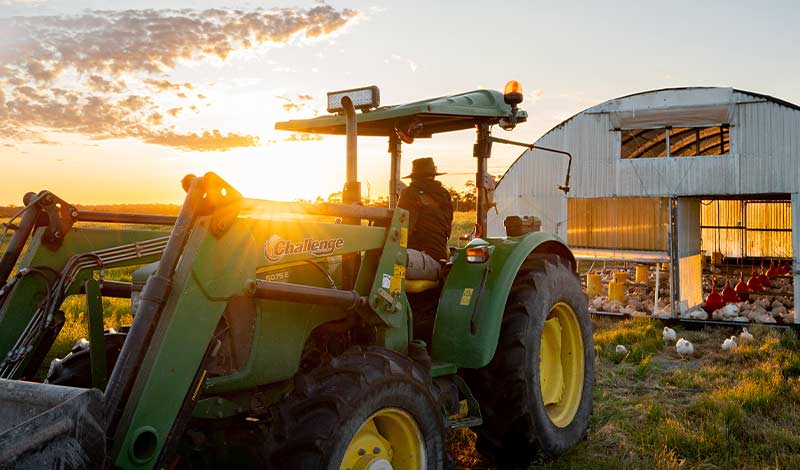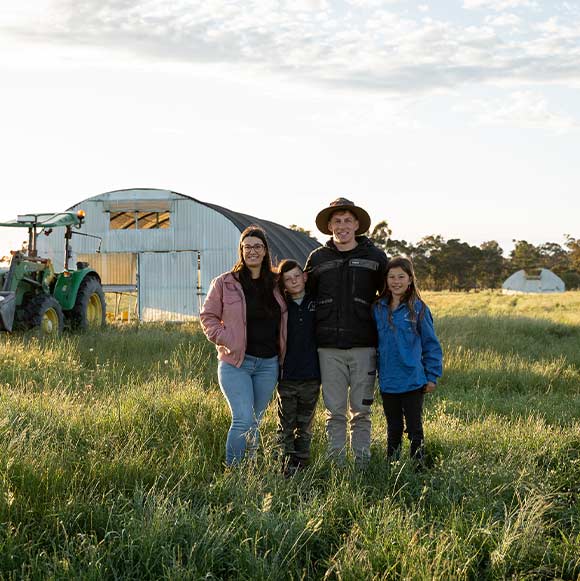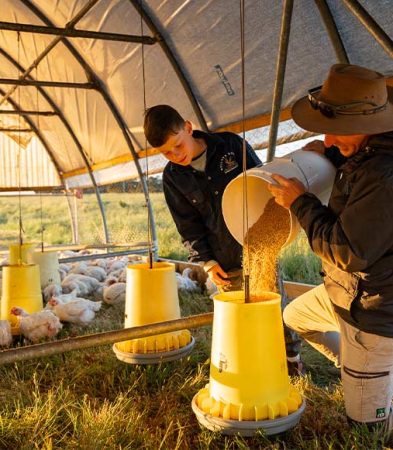Farm Life in Mount Gambier
Our farming journey first started in 2016 when Sam, after 7 and half years of working in the Hydraulic Industry, and both of us discontent with our suburban lifestyle, sold our house and packed our dog and two small children up to move to Mount Gambier, South Australia.
This gigantic step would prove to be a one of many that would inch us closer to the regenerative world. In her childhood, Steph had spent some time growing up on a small dairy farm in the South West of W.A, but other than that, our knowledge of farming and where our food came from was minimal.
Add on the struggles of trying to pay a mortgage with two small children on apprentice wages, up until then food had been something of a necessity, living off of pasta, caged eggs and supermarket branded items.
Learning Regenerative Farming Practices
The move to Mount Gambier, where Sam worked as a Dairy Hand on a 500 head dairy at a rate of $17 something an hour, was an eye opener into food production.
It led to an incessant need to know how other food was produced and whether or not our current farming systems could be better.
The more Sam looked into food production, the more he was dissatisfied. It was only when he watched the documentary, “Food Inc”, that he saw a farming system that showed a diverse array of pastures and animals that actually looked happy!
Seeing how Joel Salatin operated his farm, gave us a hope that food and farming systems could be approached in a better way that works with nature and not against it. Every free, waking hour Sam researched Regenerative Agriculture.
The Reality of Farming in Australia
He researched American Farms, Australian Farms, South African Farms. He couldn’t get enough. Eventually it got to the point where he had learned so much that, even though he enjoyed the work, he could no longer work in a conventional farming system, and applied for internships located in VIC and NSW.
Not hearing back from these positions until we were already packed up (just one year after we had moved to Mt Gambier) and with our dog and kids in the car across the Nullabor, we decided to head back home to the West.
The Reality of Farming in Australia
The idea was to find work or save up enough money to give this farming thing a go for ourselves.
The biggest challenge we faced, despite our passion, was money. It’s exceedingly expensive to farm in Australia, especially when you don’t have any land or business passed down from generation to generation.
With the average Australian Farmer in their 50’s or 60’s, we found ourselves feeling quite set apart from ‘normal’ society. After all, the average Australian in their 20’s are still out partying and earning a degree!
Back in Western Australia, Sam went back into the Hydraulic Industry. Again, the itch just wouldn’t go away.
At this stage, we thought more and more about how to get into Regenerative Agriculture for ourselves. It seemed that, with a relatively fast turn-over and minimal financial starter costs, the best viable option would be to get into raising Broilers to practice Pastured Poultry.
With only one person in Western Australia actually growing meat birds based on Joel Salatin’s model, and little to no information on how to start a Pastured Poultry business in WA, it was a bit of a battlefield trying to get the information we needed to develop a business plan.
We decided that what we needed to do was to move closer to an area where we would like to farm. Steph, having grown up in the South West, was practically jumping at the idea of moving back ‘Down South’, so that’s where we decided to go.
In July, 2018, we found ourselves moving (yet again) to the South West region to work on a small Organic Egg Farm in exchange for rent.
Steph went back to work as an Assistant in Nursing and Sam worked on the Egg Farm while we experimented, building our own Salan Chicken Tractors and raising our first ever batch of meat chickens as a trial.

The Birth of Rosa’s Ridge
In the background, Sam’s Dad had been quietly watching and, after about 8 months of us arriving in Margaret River and seeing Sam’s furious attempts to break into the Farming Sector, he drove down from Perth and proposed that he buy a property for us to lease and farm on.
With Sam’s dad having over 30 years in business, together, they founded Rosa’s Ridge which is located just outside of Margaret River, on a property Sam had first seen advertised all the way over in Mount Gambier.
We ordered a 3×1 donger and had it transported to the new property so that we could start getting to work right away. There was lots to be done. Enormous amounts of clean-up from a property that had been let go for too many years.
Navigating Challenges
It was a huge task, but with Steph still at work, Sam could focus on tidying up the property and starting the approval process with the local government bodies and relevant departments so that we could have chickens on the farm.
It took almost 12 months of writing up a Nutrient Management Plan for us to gain approval to have more that 50 chickens on our property (apparently it is SAFER to have chickens in a shed with a concrete floor than to have them roaming and pooping on pasture).
Since then it’s been an uphill battle, pioneering an industry that was almost non-existent when we first started. We’ve overcome financial problems, brooding problems, feed issues, rats, abattoir problems, approvals, butchering issues, how to sell and market and interact with customers; almost every conceivable thing that could go wrong, has!
These problems are small compared to our successes. Almost immediately, we put in underground water access over our entire property so that we could practice rotational grazing.
Sam was also focussed on creating a regenerative farming system that was efficient. We were fueled by a strong conviction that healthy, nutrient dense, ethically farmed food should be accessible for all. For families like ours.
The Chicken Chalet
All those years of researching and learning had led him to a moveable chicken house design developed by Cobb Creek Farm. A large hoop-house structure that was completely moveable and allowed the birds more freedom to do the chickeny things that chickens do.
Dust bathe, scratch, flap, run, perch, forage for bugs, eat grasses and sunbake in FRESH, clean air.
Together with Sam’s brother’s help, we developed and hand built the first Australian chicken house of this size and design ever to be used for raising meat chickens, naming it the Chicken Chalet.
Becoming Western Australia’s Premier Pastured Poultry Producers
After just 2 years, we became the largest Pastured Poultry producers in Western Australia (now there are quite a few of us, which is an exciting time for farmers and consumers alike!).
Having previously raised our day old chicks in an old, drafty dairy shed that already existed on the property, we invested in a custom built shed where the young chicks could grow safely before graduating onto pastures.
Our brooder shed features large windows and skylights for lots of natural lighting, feeders and waterers that easily move and large roll up doors to allow for cleaning with a tractor.
These small differences are what sets us apart from other producers. We don’t shy away from efficiencies and we believe that by using efficient systems, Regenerative Agriculture, specifically Pastured Poultry, has a real chance at becoming the new norm.
Alongside the Poultry, we’ve had a good shot at raising other animals within a regenerative and holistic context. We’ve tried our hand at cattle, we implemented the use of goats to help control weeds on our property, and currently, we’re having a go at pasture raised pigs for meat.
Commitment to Education and Adaptation
Our journey has been and will continue to be that of always learning and adapting.
We’re confident that together, with your help, we can change farming and food production for the better in Australia.
Positive Change in Australian Farming
More than ever, people are concerned about where their food comes from and how it is raised.
They’re sick of supporting large companies that drive down prices and cheapen industries at the cost of animal welfare, the environment and the farmer.
The change is happening now. So jump on board and be a part of the change you want to see for the future!



